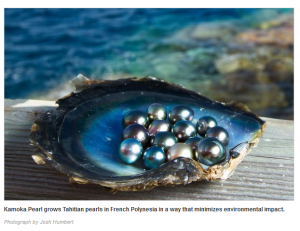 The National Geographic has just produced a marvelous essay about a farm in French Polynesia that is incorporating “sustainable” practices into its pearl farming.
The National Geographic has just produced a marvelous essay about a farm in French Polynesia that is incorporating “sustainable” practices into its pearl farming.
Josh Humbert, owner of Kamoka Pearl farm, didn’t start with a goal of developing a model for sustainable practices into pearl farming. But when he stumbled upon one that minimizes the environmental impact of farming, he embraced it and most important, shared it.
As most of you know, pearl cultivation occurs in several steps with some variation to accommodate the needs of specific mollusks.
Tahitians pearls are cultivated from spats, baby mollusks that attach themselves to a solid object placed in the lagoon. After a period of growth, usually about six months to a year, the mollusks are placed in baskets or nets to protect from predators and allowed to grow until they can accept a graft, the insertion of a bead. The bead of course stimulates nacre production and results in a pearl.
All of this takes time, lots of time. Farmers let a mollusk grow for two years before nucleation. The mollusk is then allowed to grow for another eighteen months. Sometimes a small bead is replaced with a larger bead and the mollusk experiences another period of growth.
During all this time, the mollusk has to be protected.
Part of the protection involves removing the barnacles, sponges and other marine organisms that crust the mollusk when it is grown in a net or basket.
According to the National Geographic, the mollusks in these contained growing environments are far more likely to be covered up by this crust than mollusks left exposed in open water.
If the mollusks are not cleaned, they don’t make pearls as large, so cleaning is a priority.
Farmers had a couple of standard ways of cleaning their mollusks.
The basic practice is to pull the crusted mollusks onto the deck of a boat and blast them with a powerful stream of water. However, if the wash goes back into the water, it could lead to algal blooms and deoxygenation, a small “dead” zone. That’s because the organic material being returned to the water may be too much for fish and other organisms to break down right away.
The National Geographic says “The process can also spread unwanted invertebrates like sponges around the farm or introduce them to places in high numbers that upset the ecological balance.”
A second response to the need to clean the oysters is to bring mollusks onto land to wash them. But this resulted in pools of nutrient-rich water which when put in a holding pond turned into a smelly mess.
Humbert discovered a different process. When the mollusks need cleaning they are moved to what the National Geographic calls “very shallow water.” Here, apparently dwell a number of different and hungry fish which scour the mollusks clean in several days. So, it’s a natural cleaning and feeding process.
The process is being studied by researchers at Old Dominion University in Virginia headed by Professor of Biology Kent E. Carpenter.
It’s also getting attention from the Centre for Social Responsibility in Mining at the University of Queensland in Australia and at the University of Vermont. Representatives from these groups have developed a website www.sustainablepearls.org and are planning a conference next year.
This really is a marvelous and interesting development. If you’d like to read the full article, here is the link.
,

